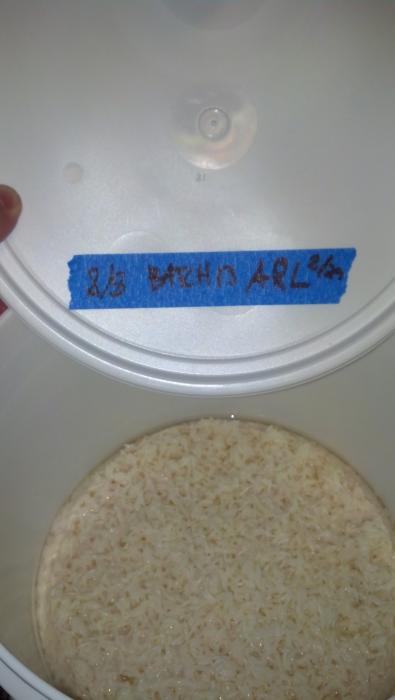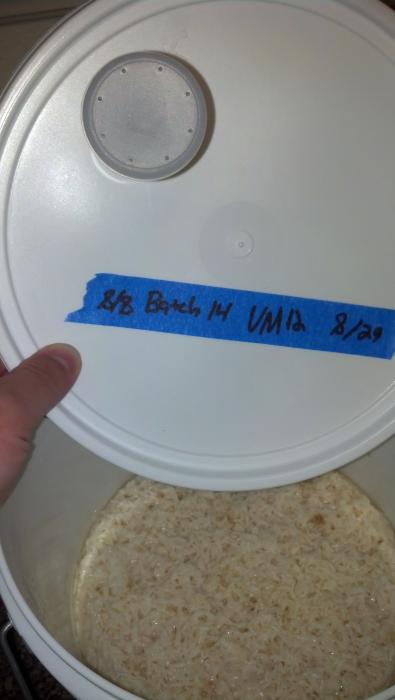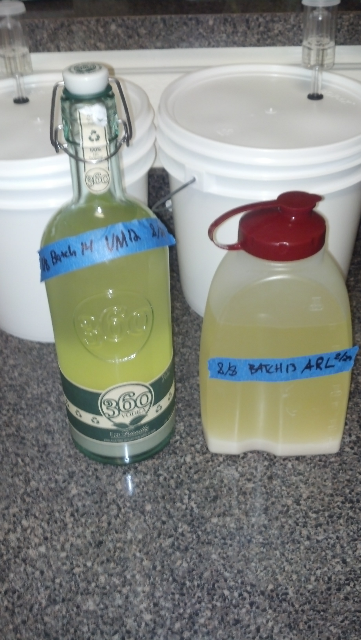ARL Vs Small Vietnamese Yeast
So here is my side by side of the above yeast. I used Mahatma jasmine rice I purchased from the local supermarket. Both were cooked using 6 cups of rice to 9 cups of water on the stove, or 1:1.5 ratio rice:water. I allowed them to cool overnight on a sheet pan in my oven and pitched 1 full packet of ARL and then pitched 12 small VM yeast balls or one full packet on the other batch. Both were fermented in 2 gallon white food grade buckets and covered with a towel to minimize light. The were placed at room temp, average 74°F.
As you can see from the pics, the ARL batches rice did not seem as liquefied. There was more solid mass and unbroken down rice in the ARL batch. The VM batch was much more soupy and the rice was broken down to a near porridge.
The smell from both was different. The ARL batch had a somewhat fruity smell. It lacked the heavy alcohol smell, but you could tell there was some there. I would call the smell of this batch pleasant. The smell of the VM batch smelled noticeably hotter. It wasn't quite rocket fuel, but damn near. Neither batch had a hint of a sour note to them.
The yield from the ARL batch was 60oz while the yield from the VM batch was 56oz. Both looked identical. I put 72 oz of water in to start with.
The taste of the ARL was similar to the smell. It tasted sweet and somewhat fruity, almost apple or pear like. It was very pleasant, but lacked the hotness I have grown accustomed to with some of these batches of rice wine. The flavor of the VM batch was exactly like it smelled. It was hot, and needs some time to mellow. It was drinkable, but a little age after pasteurization will do this one well. It was slightly sweet, but lacked much character.
Overall, the ARL made a much nicer and smoother rice wine. It did not produce near the alcohol level the VM did, but that's would made it much more drinkable. The ARL batch is drinkable now, while the VM batch may be used to mix and make my favorite apple pie rice wine.
I do have another batch working with arborio rice and the VM yeast balls. That was my best previous batch but the rice was aged. Guess we will see how this upcoming batch turns out.
Jak, thanks for ARL. If anybody is having a hard time finding it, he is on ebay. Good stuff!




So here is my side by side of the above yeast. I used Mahatma jasmine rice I purchased from the local supermarket. Both were cooked using 6 cups of rice to 9 cups of water on the stove, or 1:1.5 ratio rice:water. I allowed them to cool overnight on a sheet pan in my oven and pitched 1 full packet of ARL and then pitched 12 small VM yeast balls or one full packet on the other batch. Both were fermented in 2 gallon white food grade buckets and covered with a towel to minimize light. The were placed at room temp, average 74°F.
As you can see from the pics, the ARL batches rice did not seem as liquefied. There was more solid mass and unbroken down rice in the ARL batch. The VM batch was much more soupy and the rice was broken down to a near porridge.
The smell from both was different. The ARL batch had a somewhat fruity smell. It lacked the heavy alcohol smell, but you could tell there was some there. I would call the smell of this batch pleasant. The smell of the VM batch smelled noticeably hotter. It wasn't quite rocket fuel, but damn near. Neither batch had a hint of a sour note to them.
The yield from the ARL batch was 60oz while the yield from the VM batch was 56oz. Both looked identical. I put 72 oz of water in to start with.
The taste of the ARL was similar to the smell. It tasted sweet and somewhat fruity, almost apple or pear like. It was very pleasant, but lacked the hotness I have grown accustomed to with some of these batches of rice wine. The flavor of the VM batch was exactly like it smelled. It was hot, and needs some time to mellow. It was drinkable, but a little age after pasteurization will do this one well. It was slightly sweet, but lacked much character.
Overall, the ARL made a much nicer and smoother rice wine. It did not produce near the alcohol level the VM did, but that's would made it much more drinkable. The ARL batch is drinkable now, while the VM batch may be used to mix and make my favorite apple pie rice wine.
I do have another batch working with arborio rice and the VM yeast balls. That was my best previous batch but the rice was aged. Guess we will see how this upcoming batch turns out.
Jak, thanks for ARL. If anybody is having a hard time finding it, he is on ebay. Good stuff!













![Craft A Brew - Safale S-04 Dry Yeast - Fermentis - English Ale Dry Yeast - For English and American Ales and Hard Apple Ciders - Ingredients for Home Brewing - Beer Making Supplies - [1 Pack]](https://m.media-amazon.com/images/I/41fVGNh6JfL._SL500_.jpg)



















































